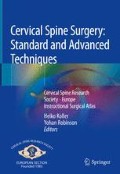Abstract
The transnasal endoscopic approach to the craniocervical junction is used in lesions compressing the medulla posterior. Pathologies include dens invagination in rheumatoid arthritis, deformities such as os odontoideum, or neoplasms such as craniocervical chordomas. In the sagittal plane, generally the base of C2 is the caudal limit. In the coronal plane, the dens can be resected with practically no side effects; resection beyond this carries the risk of damage to the caudal cranial nerve, the carotid and vertebral artery, or the Eustachian tube. If the anterior arch of C1 and the odontoid process are resected in the course of the surgery, this segment gets unstable with the need for dorsal fusion. Since most of the pathologies are extradural, csf leaks are rarely challenging conditions. Technically, this approach is not highly demanding, which allows also the nonextensively experienced transnasal endoscopist to perform this surgery safely.
Access this chapter
Tax calculation will be finalised at checkout
Purchases are for personal use only
Bibliography
Fujii T, Platt A, Zada G. Endoscopic endonasal approaches to the craniovertebral junction: a systematic review of the literature. J Neurol Surg B Skull Base. 2015;76(6):480–8. https://doi.org/10.1055/s-0035-1554904.
Goldschlager T, Härtl R, Greenfield JP, Anand VK, Schwartz TH. The endoscopic endonasal approach to the odontoid and its impact on early extubation and feeding. J Neurosurg. 2015;122(3):511–8. https://doi.org/10.3171/2014.9.JNS14733.3.53.
Gempt J, Lehmberg J, Grams AE, Berends L, Meyer B, Stoffel M. Endoscopic transnasal resection of the odontoid: case series and clinical course. Eur Spine J. 2011;20(4):661–6. https://doi.org/10.1007/s00586-010-1629-x.
Seker A, Inoue K, Osawa S, Akakin A, Kilic T, Rhoton AL Jr. Comparison of endoscopic transnasal and transoral approaches to the craniovertebral junction. World Neurosurg. 2010;74(6):583–602. https://doi.org/10.1016/j.wneu.2010.06.033.
Nayak JV, Gardner PA, Vescan AD, Carrau RL, Kassam AB, Snyderman CH. Experience with the expanded endonasal approach for resection of the odontoid process in rheumatoid disease. Am J Rhinol. 2007;21(5):601–6.
Author information
Authors and Affiliations
Corresponding author
Editor information
Editors and Affiliations
Electronic Supplementary Material
(MP4 77090 kb)
Data 13.2
(PPTX 108348 kb)
Rights and permissions
Copyright information
© 2019 Springer Nature Switzerland AG
About this chapter
Cite this chapter
Lehmberg, J., Meyer, B. (2019). Endonasal Approach to the Craniocervical Junction. In: Koller, H., Robinson, Y. (eds) Cervical Spine Surgery: Standard and Advanced Techniques. Springer, Cham. https://doi.org/10.1007/978-3-319-93432-7_13
Download citation
DOI: https://doi.org/10.1007/978-3-319-93432-7_13
Publisher Name: Springer, Cham
Print ISBN: 978-3-319-93431-0
Online ISBN: 978-3-319-93432-7
eBook Packages: MedicineMedicine (R0)

